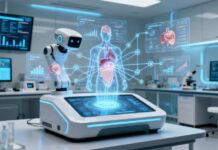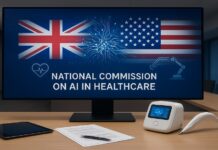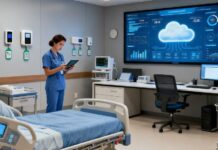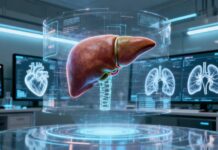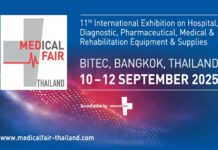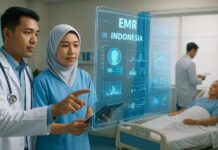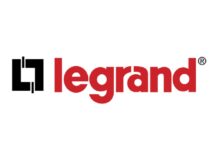Smart hospitals are transforming healthcare surroundings with innovative techniques such as predictive analytics and cutting-edge cleaning procedures.
Smart hospitals use cutting edge technology to improve patient care and operational effectiveness, revolutionizing the delivery of healthcare.
These developments use smart technology to drive digital transformation, which enhances patient safety and opens up new avenues for creative medical problem-solving.
Modern technology is essential to changing conventional medical procedures in smart hospitals. These cutting-edge technologies, which range from real-time monitoring systems to digital records management, optimize workflows, lower mistake rates, and improve patient outcomes overall.
In smart hospitals, where cutting-edge technology guarantees the wellbeing of people receiving medical care, patient safety is given first priority.
Healthcare practitioners may proactively detect and manage possible dangers by using wearables, smart sensors, and AI-driven prediction technologies. This will eventually result in a safer environment for patients and staff.
The incorporation of these technologies represents a noteworthy advancement in the advancement of improved healthcare procedures and results.
Disinfection systems with automation: UV-C light solutions and robots
In order to keep healthcare environments clean and lower the risk of infection, automated disinfection systems that use UV-C light solutions and robots are essential.
One important part of smart technology applications that aims to improve infection control methods is robot disinfection. These robots have UV-C light solutions installed, which have been shown to be successful in eliminating a variety of diseases, such as viruses and bacteria.
These systems’ automatic cleaning guarantees that different surfaces are thoroughly disinfected, reducing the spread of dangerous bacteria.
The efficiency of UV-C is especially important for getting rid of germs that are hard to get rid of using conventional cleaning techniques.
These automated disinfection systems provide a more sophisticated and effective method of sanitizing healthcare surroundings by using the power of UV-C radiation.
By integrating these cutting-edge technology into regular cleaning procedures, hospitals may improve their general safety and cleanliness, which in turn leads to improved patient outcomes and lower infection rates.
Monitoring in real time and data analysis
By giving quick insights into the pathogen levels and infection risks in healthcare settings, real-time monitoring and data analytics transform infection control.
Real-time monitoring and data-driven insights enable the retrieval of actionable data for preemptive responses to possible threats.
Hospitals may improve monitoring and infection control protocols and achieve more successful infection prevention procedures by using analytics-driven solutions.
Technology integration improves the efficacy of surveillance by facilitating faster discovery of new problems and allowing prompt measures to limit epidemics.
Healthcare institutions may use real-time data analytics to foresee possible threats and take preventative action to keep personnel and patients safe.
In addition to improving infection control, this proactive strategy raises patient safety standards generally in hospital settings.
Monitoring adherence to staff and patient hygiene
In order to improve infection control, hospitals monitor staff and patient hygienic compliance using wearables and smart sensors. Sustaining the highest levels of patient safety requires meticulous surveillance of hygiene.
Because wearable technology provides real-time data on hand hygiene habits and general cleanliness, it is essential for assuring compliance monitoring.
These wearables’ integrated smart sensors can track when employees wash their hands both before and after interacting with patients, encouraging staff responsibility.
Hospitals may proactively resolve compliance concerns and lower the risk of infections spreading inside healthcare facilities by keeping an eye on cleanliness procedures.
Wearable technology helps hospitals maintain strict infection control procedures and provide a better atmosphere for both patients and employees by making hygiene tracking and compliance monitoring easier.
The use of AI to the forecasting and containment of disease outbreaks
Artificial intelligence is used by smart hospitals to anticipate and stop any illness outbreaks. Infection modeling and outbreak prevention greatly benefit from predictive analytics, which is driven by machine learning and artificial intelligence algorithms.
Through the analysis of massive volumes of data from several sources, including staff schedules, patient records, and environmental conditions, artificial intelligence (AI) is able to recognize patterns and trends that may presage an epidemic.
AI uses complex algorithms to forecast the risk of illnesses spreading in a hospital setting, enabling medical institutions to take preventative action before outbreaks happen.
Smart hospitals can better allocate resources, carry out focused treatments, and improve overall infection control practices thanks to these AI-driven forecasts.
Cross-contamination may be decreased using IoT devices.
In healthcare settings, IoT-enabled devices reduce the danger of cross-contamination and improve the efficiency of contact tracking. The integration of wearable trackers into smart hospital technologies facilitates the real-time tracking of patient and staff movements, hence expediting the detection of possible infection transmission.
In order to effectively minimize cross-contamination, IoT contact tracking is essential for mapping interactions and pinpointing high-risk regions for focused cleaning procedures.
Hospitals may lessen the chance of significant outbreaks by using these technologies to execute proactive infection control techniques, such as isolating people who may have been exposed to infectious bacteria.
Wearables with smart sensors included in provide useful information for analyzing hygienic compliance among medical staff and improving general safety procedures.
Reducing exposure in medical facilities
Virtual check-ins and remote consultations have many benefits. They reduce the need for in-person visits by enabling patients to get medical treatment from the comfort of their homes.
Telehealth patient monitoring has advantages for both patients and medical professionals. It makes it possible to follow symptoms and vital signs in real time without running the danger of an in-hospital stay.
In addition to improving patient safety, remote patient monitoring also makes healthcare delivery more effective. In smart hospitals, using these technologies is essential to reducing hazards inside the hospital and fostering a safer environment for patients and healthcare staff.
Future directions and obstacles in technology-driven infection control
In light of the technological advances in infection control, you need to be aware of the new issues and developments that lie ahead in this important area of healthcare.
Upcoming Difficulties
- Adjusting to microorganisms that are changing and to antibiotic resistance.
- Guaranteeing the compatibility of different infection control systems.
Striking a balance between the necessity for significant data collecting and privacy considerations.
Trends in Technology
- AI and machine learning are being used more and more to avoid infections.
- Blockchain integration for safe data exchange in medical advances.
- Developments in wearable technologies to detect infections in real time.
Innovations in healthcare
- Creation of intelligent hospital rooms with surfaces that can self-clean.
- Use predictive analytics to anticipate future epidemics.
- Robotics application for complete and effective disinfection procedures.
It will be essential to keep ahead of these issues and developments as technology continues to revolutionize infection control in order to protect patient safety and improve overall healthcare results.



